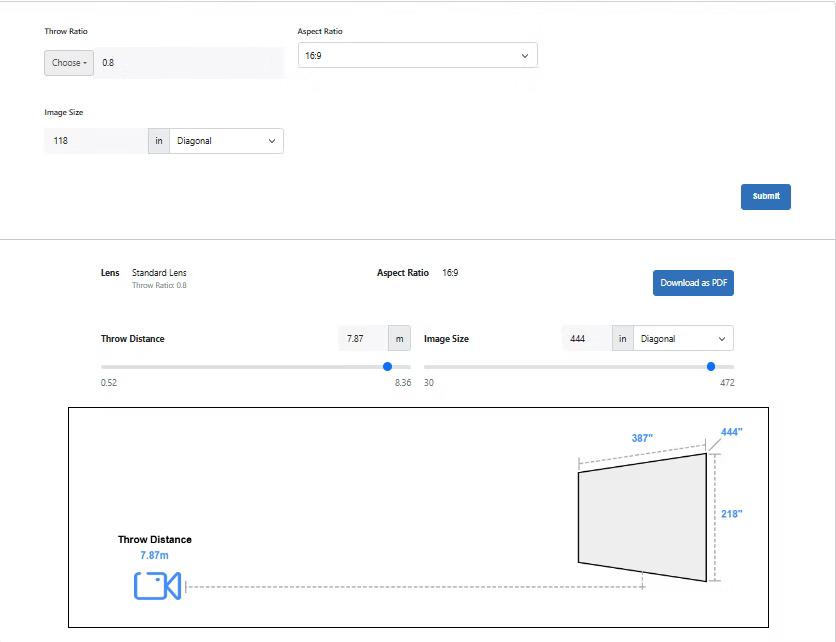Throw Ratio Explained: Get the Perfect Image Every Time

One of the most critical factors in achieving a flawless home theater experience is understanding your projector’s Throw Ratio. The throw ratio determines how far a projector needs to be from the screen to produce a specific image size. XTEN-AV emphasizes that mastering this concept is essential for creating a Perfect Projector Layout that delivers clear, bright, and distortion-free images every time.
Introduction
When setting up a home theater, many people focus on resolution, screen size, or projector brightness, but overlook the importance of throw ratio. An incorrect throw distance can result in an image that is too large or too small, causing distortion, blurred edges, or keystone correction issues.
Throw ratio is a simple yet powerful specification that allows you to match your projector to your room dimensions and desired screen size. By understanding throw ratio, you can confidently select a projector, position it correctly, and achieve a professional-quality image regardless of your room’s size or shape.
What is Throw Ratio?
Throw ratio is the ratio of the distance from the projector lens to the screen (throw distance) to the width of the projected image. It is usually expressed as a number or a range, for example, 1.5:1.
-
Formula: Throw Ratio = Throw Distance ÷ Image Width
-
Example: A projector with a throw ratio of 1.5:1 placed 9 feet from the screen will produce an image 6 feet wide.
The throw ratio determines whether a projector is standard, short-throw, or ultra-short-throw. Standard projectors require more distance from the screen, while short-throw and ultra-short-throw projectors can create large images from much closer distances.
Why Throw Ratio Matters
Throw ratio affects several aspects of your home theater setup:
-
Image Size: Ensures the projected image fills the screen without cutting off edges.
-
Room Fit: Allows the projector to work within the available space, especially in small rooms or unconventional layouts.
-
Image Quality: Minimizes the need for excessive digital keystone correction, preserving sharpness and brightness.
-
Viewing Comfort: Prevents overly large or small images that can strain the eyes or disrupt immersion.
XTEN-AV highlights that understanding throw ratio is crucial for achieving a Perfect Projector Layout, especially in rooms with fixed dimensions or unique shapes.
Types of Projectors Based on Throw Ratio
-
Standard Throw Projectors:
-
Throw Ratio: 1.5:1 to 2.5:1
-
Best suited for medium to large rooms with sufficient distance between the projector and screen.
-
Require careful planning of ceiling mounts or rear placement to achieve the desired image size.
-
-
Short-Throw Projectors:
-
Throw Ratio: 0.5:1 to 1.5:1
-
Can project large images from a short distance.
-
Ideal for bedrooms, apartments, or rooms with limited space.
-
-
Ultra-Short-Throw Projectors:
-
Throw Ratio: Less than 0.5:1
-
Sit very close to the screen, often just inches away.
-
Perfect for small rooms, corner installations, or interactive setups.
-
Selecting the right type based on your room size and desired screen width ensures optimal image quality without sacrificing comfort.
How to Calculate Throw Distance
To determine the optimal projector placement, use the throw ratio formula:
-
Measure the width of your screen.
-
Multiply the screen width by the projector’s throw ratio.
-
The result is the ideal distance from the projector lens to the screen.
Example:
-
Screen width: 8 feet
-
Projector throw ratio: 1.3:1
-
Throw distance = 8 × 1.3 = 10.4 feet
This calculation ensures your image fits perfectly on the screen without distortion.
Tips for Achieving a Perfect Image
-
Consider Room Dimensions: Measure your room carefully and account for obstacles, furniture, or wall angles.
-
Use Lens Shift Wisely: Adjust the projector vertically or horizontally to align the image without excessive digital keystone correction.
-
Account for Ceiling Height: Higher ceilings may require adjustable mounts or drop kits to maintain proper image alignment.
-
Select the Right Projector Type: Match your throw ratio to your room size and desired image width to avoid over-stretching the image.
-
Test Before Final Installation: Use temporary mounts or templates to preview the image size and alignment before securing the projector permanently.
XTEN-AV recommends using design software or online calculators to simulate throw distances and visualize your layout for precise results.
Common Throw Ratio Mistakes
-
Ignoring Room Size: Choosing a standard throw projector for a small room can produce an oversized image that distorts and overwhelms the space.
-
Overusing Keystone Correction: Digital correction can reduce image sharpness and brightness if the projector is too far or too close to the screen.
-
Neglecting Ceiling Height: High-mounted projectors without proper lens shift can result in angled or cropped images.
-
Incorrect Screen Placement: Misalignment between screen and projector affects viewing comfort and image geometry.
Avoiding these mistakes ensures your home theater maintains a professional, cinematic feel.
Conclusion
Understanding Throw Ratio is fundamental to designing a home theater that delivers clear, immersive, and visually balanced images. By carefully calculating throw distance, selecting the right type of projector, and accounting for room dimensions, ceiling height, and seating position, you can achieve a Perfect Projector Layout that maximizes both comfort and image quality.
XTEN-AV’s expertise in AV system design and projector planning ensures that every setup, from compact bedrooms to dedicated home theaters, meets professional standards. With the right knowledge and tools, you can enjoy the perfect image every time and create a cinematic experience that rivals any theater.
Read more: https://avfusionhorizon.weebly.com/blog/what-is-throw-ratio-and-why-it-matters
- Art
- Causes
- Best Offers
- Crafts
- Dance
- Drinks
- Film
- Fitness
- Food
- Spellen
- Festival
- Gardening
- Health
- Home
- Literature
- Music
- Networking
- Other
- Party
- Religion
- Shopping
- Sports
- Theater
- Wellness



